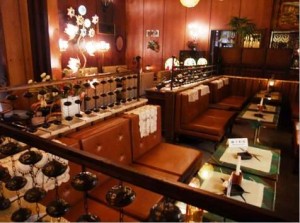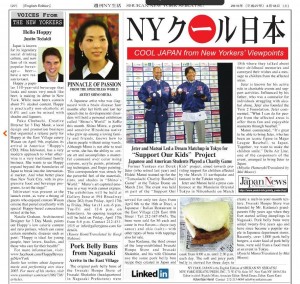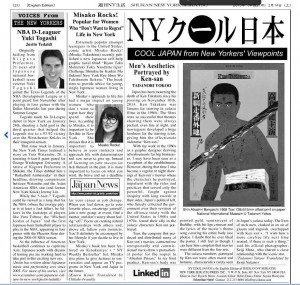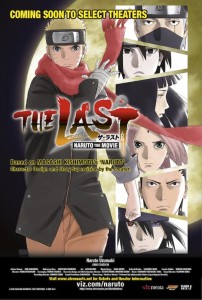JQ Magazine: Book Review — ‘Monkey Business Volume 5’
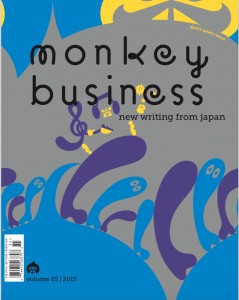
“Monkey Business is a magnetic force that attracts writers who can create magical kingdoms in a single page.” (A Public Space)
By Brett Rawson (Akita-ken, 2007-09) for JQ magazine. Brett is a writer, translator, and Ramen Runner. He has an MFA in Creative Writing Non-Fiction from The New School, and his writing has appeared in Narratively and Nowhere magazine. He is also co-founder of the quarterly publication The Seventh Wave and founder of Handwritten, a place in space for pen and paper.
After reading Monkey Business Volume 5, the image of a blender might pop into your mind. Perhaps this is because it is almost summer and you have recently begun making smoothies in the early morning. Or perhaps this is because you came across the description Monkey Business as genre-defying, which made you think of cross-genre, blending boundaries, and thereafter, the physical image of the object itself: the blender.
But most likely, this is because you read the opening vignette to Monkey Business, “Photographs Are Images,” by rising Japanese writer Aoko Matsuda, which ends as such:
Everything you’ve read up to this point has been images. […] These strings of letters are images. These chains of words are images. Stories are images. The story you’re reading this very minute is an image.
Carefully selected as the opener to Volume 5, this year’s Monkey Business is all about ways of seeing, and perceiving, images and the imagination, and objects and subjects.
Justin’s Japan: Nippon in New York — Pokémon Symphony, Hiromi, Kamijo, ‘ROBOT,’ AnimeNEXT

“Pokémon: Symphonic Evolutions” debuts at the Theater of Madison Square Garden June 6. (Princeton Entertainment)
By JQ magazine editor Justin Tedaldi (CIR Kobe-shi, 2001-02) for Examiner.com. Visit his Japanese culture page here for related stories.
After an unusually chilly spring, it’s finally starting to feel like summer. Enjoy some seasonal events this month that celebrate the best of both fine art and pop art.
This month’s highlights include:
June 4-5, 6:30 p.m.
New York Japan CineFest 2015: Program 1 & Program 2
Asia Society, 725 Park Avenue
$12, $10 students/seniors, $8 members
Co presented by Asia Society and Mar Creation, Inc., New York Japan CineFest highlights some of the most exciting new voices in cinema, presenting two nights of short films by emerging Japanese and Japanese American filmmakers. The first night features all-new works made within the last year, while the second night’s program spotlights female directors and is followed by a Q&A with Ema Ryan Yamazaki (Monk by Blood) and Hazuki Aikawa (Reflection). The first night’s program is followed by a reception.
June 4-7, 8:00 p.m. and 10:30 p.m.
Hiromi Trio Project featuring Anthony Jackson and Simon Phillips
Blue Note Jazz Club, 131 West Third Street
$40, $55
Part of the Blue Note Jazz Festival! A native of Hamamatsu, Japan, Grammy-winning pianist and composer Hiromi Uehara is one of the world’s top young international performers in jazz. As part of the Trio Project with bassist Anthony Jackson (Paul Simon, the O’Jays, Steely Dan, Chick Corea) and drummer Simon Phillips (the Who, Judas Priest, David Gilmour, Jack Bruce), her passionate and incendiary keyboard work has been a shining light on the jazz landscape since her 2003 debut. She takes up a four-night residency at the Blue Note in support of her latest album with the Trio Project, Alive, which was released in 2014.
June 5-6. 7:30 p.m.
Kota Yamazaki/Fluid hug-hug OQ
Japan Society, 333 East 47th Street
$25, $20 Japan Society members
Global traditions flow together in this latest work by Bessie Award-winning choreographer Kota Yamazaki. Inspired by Japanese ritual poetry readings held at the Imperial Palace, Yamazaki’s OQ (ōkyu is the phonetic reading of the Japanese word for “palace”) features dancers from diverse cultural and dance backgrounds including Western contemporary, butoh and hip-hop. Within a space designed by award-winning New York architect collective SO-IL that complements the dancers’ fluid motions, Yamazaki’s palace, with its own rituals and customs, comes to life before your eyes. The Friday, June 5 performance is followed by a MetLife Meet-the-Artists Reception.
For the complete story, click here.
JQ Magazine: JQ&A with Merry White on ‘Kissaten: Japanese Cafes Past and Present’
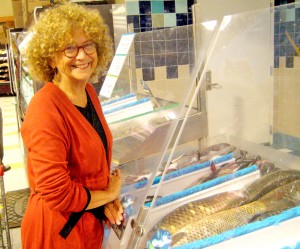
“Japanese coffee standards are the highest—when there is a new varietal on the market, it is often sent to Japan for testing. If a bean can make it in Japan, it can make it anywhere. The quality tasters are very keen, and there are fewer defective beans permitted than anywhere in the world.” (Courtesy of Merry White)
Brewing Up Something at Japan Society
By Alexis Agliano Sanborn (Shimane-ken, 2009-11) for JQ magazine. Alexis is a graduate of Harvard University’s Regional Studies-East Asia (RSEA) program, and currently works as an executive associate at Asia Society in New York City.
When it comes to notable food and drink of Japan, for many “coffee” is not the first thing that comes to mind. Yet, on May 21, Merry (Corky) White, Professor of Anthropology at Boston University, will teach audiences at Japan Society in New York City just how robust their coffee culture is, and how exacting their measurements are. Get ready for something good at Kissaten: Japanese Cafes, Past and Present.
White’s no newbie to food and Japan—it’s been much of the foundation of her professional work. If you look her up on Amazon, you’ll see that she’s been publishing food-related books since the mid-1970s, and regularly offers contributions to publications the world over. Definitely a foodie—and someone who knows her stuff. When not researching coffee and cafes, she’s active teaching about Japanese society, women in Asia, food and culture, and the anthropology of travel and tourism. Check her out on Twitter, where she regularly posts food- and culture-related content.
To whet your appetite for this program, JQ recently caught up with White to learn more about the coffee world in Japan, and what we can expect to hear from this rich presentation.
At your lecture at Japan Society, what do you hope to teach the audience about Japanese coffee culture?
I hope to surprise at least a few people, who may not yet know that Japanese coffee is a well-rooted, well-developed cultural product with a deep history. The coffee experience is also about cafes, koohii hausu, and kissaten, places with a special meaning that have developed over time in Japan. These places have offered people various distinctive experiences, depending on the era. The first ones, in the Meiji period (1868-1912), gave people a window on Europe, decor, clothing, foods—which continued into the Taisho period (1912-1926) when the flappers and lounge lizards demonstrated a new modernity, and the urban cultures were changing to, for example, give women a place in public, too. It was fine for a young woman of good family in the daytime, anyway, to go to a cafe, though probably she might have a chaperone…
Can you describe an iconic Japanese-style kissaten?
Kissaten are now places of memory, as well as ordinary community life. Brown kissa are the “sepia-toned” places where especially middle-aged people (I would say over 60s) like to go for a nice place to sit and get good service and maybe see friends. Young people like them, too, as they often share a love of the past (one they wouldn’t have had themselves) as a retro experience. Kissaten, though, also have more contemporary styles.
JQ Magazine: Book Review — ‘Gon, the Little Fox’
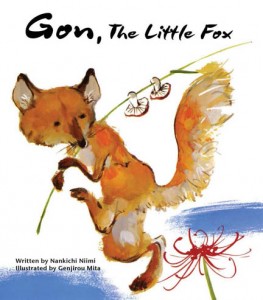
“Written by the legendary children’s book author Nankichi Niimi when he was just seventeen years old, the story brings to life a little rascal who never passes up a chance to cause havoc.” (Museyon)
By Rashaad Jorden (Yamagata-ken, 2008-10) for JQ magazine. A former head of the JETAA Philadelphia Sub-Chapter, Rashaad is a graduate of Leeds Beckett University with a master’s degree in responsible tourism management. For more on his life abroad and enthusiasm for taiko drumming, visit his blog at www.gettingpounded.wordpress.com.
You probably remember reading some of Aesop’s Fables—such as “The Tortoise and the Hare” and “The Boy Who Cried Wolf”—during your childhood. Or more importantly, the lessons those fables are supposed to teach.
Likewise, your students in Japan likely read similar tales, and one of them might have been Gon, the Little Fox. Written by the legendary children’s book author Nankichi Niimi (1913-1943) when he was just seventeen years old, the story brings to life a little rascal who never passes up a chance to cause havoc, like setting fire to rapeseed husks held out in the sun, to dry to stealing a farmer’s cayenne peppers.
However, Gon realizes he’s gone too far when he kills an eel intended to be eaten by the ailing mother of a villager named Hyoju. To atone for his egregious misdeed, Gon repeatedly gathers, among other objects, mushrooms and chestnuts to leave at Hyoju’s house. But Gon’s attempts at forgiveness are never acknowledged and the story ends tragically. (Premature deaths were an unfortunate aspect of Niimi’s life; his mother passed away when he was four and he himself died when he was twenty-nine.)
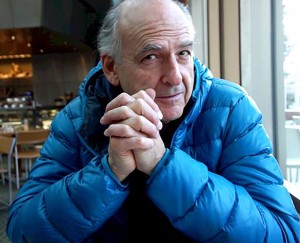
“By dramatizing some of the people who were on the receiving end of that racial hatred, I think the book might give a concrete sense of what American power can do when it is unleashed against people in other parts of the world. I hope the experiences of Jiro and Mitsuko make readers think twice about that.” (Louis Templado)
By Julio Perez Jr. (Kyoto-shi, 2011-13) for JQ magazine. A bibliophile, writer, translator, and graduate from Columbia University, Julio has had experience working at Ishikawa Prefecture’s New York office while seeking opportunities with publications in New York. Follow his enthusiasm for Japan, literature, and comic books on his blog and Twitter @brittlejules.
A Professor Emeritus of Harvard University, Jay Rubin has also served as a distinguished translator of Japanese literature for more than a quarter century, most notably on the works of Haruki Murakami. June 2 marks the release of his debut novel The Sun Gods (Chin Music Press), which is set in Seattle during World War II and explores the relationships between a Seattle-based Japanese national named Mitsuko and her young adopted American toddler, Billy, who are both interned by the U.S. government at the beginning of the war. Years later, Billy begins a journey to newly reconstructed Japan to find his Japanese mother and learn the truth about their shared past.
As part of the book’s launch, Rubin will be making live appearances from coast to coast, starting with Japan Society in New York on May 7 for an event titled The Magical Art of Translation: From Haruki Murakami to Japan’s Latest Storytellers, featuring other guest authors and moderated by JET alum Roland Kelts (Osaka-shi, 1998-99).
In this exclusive interview, Rubin shares with JQ the legacy of the war on his own writing, the attention to historical detail that went into The Sun Gods (with a few liberties taken), and what makes translating Japanese such a liberating experience.
JQ magazine readers are primarily JETs, JET alumni, and others who have worked and resided in Japan or have a strong interest in the country. Could you tell us about what inspired you to study Japanese language and culture and about any time you spent living in Japan?
In my second year at the University of Chicago, I was going to take one course on something non-Western for the fun of it, and one of the courses that happened to be available was an introduction to Japanese literature (in English translation, of course). I was so fascinated by the literature and by the professor’s remarks on the original language that I immediately started studying that language. I sometimes wonder what would have happened if the course I stumbled into happened to be Chinese history. I spent four years studying the language in Chicago before going to the country itself on a Fulbright fellowship. My spoken Japanese was so bad, all I could say to the young woman bartender at the first bar I wandered into was, “Do you realize you just used the word ‘wake‘ (わけ) three times?” I studied in Tokyo for two years, often wish I had made it four. I’m still remarking on how many times people use wake in sentences. I studied mostly Meiji literature while I was in Tokyo, not Noh drama like The Sun Gods’ Bill, though Noh was a side interest, and I did a lot more work on it in later years.
To start off talking about The Sun Gods, how would you describe your new book to potential readers?
This may sound like ad copy, but I’m comfortable with the summary on the book’s front flap:
Opening in the stress-filled years before World War II, The Sun Gods brings together a white minister to a Seattle Japanese Christian church, his motherless young son, and a beautiful new arrival from Japan with a troubled past. The bombing of Pearl Harbor intrudes upon whatever happiness they might have had together, and the combination of race prejudice and war hysteria carry the action from Seattle to the Minidoka Internment Camp in Idaho. Nearly two decades later, the son is ready to graduate from college when memories of Minidoka and of his erstwhile Japanese mother begin to haunt him, and he embarks on a journey that will lead him from Seattle’s International District to war-ravaged Japan in his attempt to discover the truth about his past.
The internment of people of Japanese ancestry in America that occurred during World War II is rarely dwelled on as much as other events of the war, how would you explain the internment and the reasons it warrants further attention to someone unfamiliar with the topic? What is the most important message you hope to get across?
If there’s a “message,” it’s to convey a historical moment, central to which was the fact that our government established concentration camps within its borders in order to lock up members of a particular racial group, and that this was supported by both public opinion and the Supreme Court with no constitutional justification whatsoever. The government has since apologized openly and eloquently, thus making a repeat performance highly unlikely. Japanese-American organizations, it should be noted, were among the most outspoken against anti-Muslim racism following 9/11.
Justin’s Japan: Hello Hoppy
By JQ magazine editor Justin Tedaldi (CIR Kobe-shi, 2001-02) for Shukan NY Seikatsu. Visit his Examiner.com Japanese culture page here for related stories.
Japan is legendary for its social drinking culture, and now fans of its most popular beverage—beer—have a new reason to toast.
Hoppy, a popular 110-year-old beverage that looks and tastes very much like beer, is making its debut in New York. While most beers contain about 5% alcohol content, Hoppy is practically non-alcoholic at 0.8%, and can be mixed with shochu and liqueurs.
Fuko Chubachi, creative director for 3 Day Monk, a local design and promotion business that organized a release party for Hoppy at East Village eatery Wasan on April 9, explains its arrival in America: “Hoppy’s CEO, Mina Ishiwatari, has a very modern approach to what otherwise is a very traditional family business. She wants to see Hoppy expand beyond the boundaries of Japan to break into the international market. And what better place than New York City, with its progressive food and beverage programs, to set the stage!”
Ishiwatari was present at the launch event, as were a throng of guests who enjoyed some custom Wasan cuisines that paired excellently with special Hoppy-based concoctions mixed at the bar.
Natalie Graham, architectural designer for 3 Day Monk, points out Hoppy’s low calorie content and zero purines, which can cause certain metabolic diseases such as gout: “Hoppy is ideal for young people, beer lovers, foodies, and those who care for their health!”
For more information, visit www.facebook.com/HoppyBeverageNewYork
Emily Metzgar’s op-ed: “The JET Program and the US-Japan Relationship”
A great summary of the long-term value of the JET Program (i.e., Return on JET-vestment) by University of Indiana journalism professor (and JET alum) Emily Metzgar:
The JET Program and the US-Japan Relationship: Alumni of the Japan Exchange and Teaching Program are an important part of bilateral ties.
As official Washington prepares for the late April visit of Japanese Prime Minister Shinzo Abe and his scheduled address to a joint session of Congress, many aspects of the bilateral relationship between the United States and Japan will rightly be feted, including a robust strategic alliance and significant economic ties between the two nations. The visit also presents an opportunity to consider a less discussed but increasingly important aspect of the U.S.-Japan relationship writ large: The extensive – and growing – network of American alumni of Japan’s long-standing Japan Exchange and Teaching (JET) Program.
Click here to read the rest of the op-ed: http://thediplomat.com/2015/04/the-jet-program-and-the-us-japan-relationship/
JQ Magazine: JQ&A with Chin Music Press Owner Bruce Rutledge

“JETs have a special bond, somewhat like people who go to the same university, and I think returning JETs can exploit that connection to open a few doors. JETs and MEFs are in all sorts of powerful positions these days at multinationals, news agencies, nonprofits, and government jobs. Use that network!” (Courtesy of Bruce Rutledge)
By Julio Perez Jr. (Kyoto-shi, 2011-13) for JQ magazine. A bibliophile, writer, translator, and graduate from Columbia University, Julio is currently working at Ishikawa Prefecture’s New York office while seeking opportunities with publications in New York. Follow his enthusiasm for Japan, literature, and comic books on his blog and Twitter @brittlejules.
After spending a few years in Chiba doing teaching and promotional work that would be all too familiar to JET ALTs and CIRs, Bruce Rutledge went on to work as an editor and writer in Japan for over 15 years. Today, he is the owner of Chin Music Press, a publishing company in Seattle with strong ties to Japan.
In this exclusive interview, Rutledge discusses his time as a Monbusho English Fellow (MEF), which was in some ways a precursor to the JET Program, and shares some of his experiences in a variety of media positions in Japan along with the origin and direction of Chin Music Press.
Since most of our readers are JET alumni, they’re probably already wondering about your connection to JET. Would you mind telling us a bit about the Monbusho English Fellowship you participated in? Why were you drawn to that program? Where in Japan were you placed, and how would you describe your activities as a Monbusho English Fellow? Also, how would you connect MEF with JET and compare it to what JET eventually became?
I was an MEF from 1985 to 1987 in Funabashi, Chiba, I think my job was sort of a combination of a CIR and a teaching assistant. I spent every Monday in the city hall doing PR work for Funabashi, whose slogan was “We More Sports.” I talked to them about this thing called a verb and how their slogan needed one, but my intervention was too late. Tuesday through Friday, I would teach in the schools. I taught a whole year at one high school and spent the rest of the time rotating from middle school to middle school with an occasional elementary school visit thrown in. It was a memorable period of my life. I loved my time there.
Are there any special anecdotes you would like to share from your time in Japan?
Perhaps the time a neighborhood kid of five or six broke into my apartment by climbing through an open window. The little burglar left his shoes on the windowsill. It was just the sort of juxtaposition I love about Japan.
When you finished with MEF, what was your next job? At that time, what direction did you see your life taking, and how did the your path end up differing?
After MEF life, I moved about 15 stops down the Sobu Line to Suidobashi and took a job with Universal News Japan. I was an editor and had planned to have a career in journalism. That plan worked out for nearly 15 years, until the Internet changed everything and I started longing to work in a longer form.
You seem to have had many media-related positions, mostly involving Japan or Asia. How would you describe the kind of work you did post-MEF? During those times, were you living primarily in Japan or somewhere else? How did that impact your performance in those jobs?
I lived in Japan for 15+ years. I never lived in another Asian country. I was a Louis L’Amour of white-collar jobs, doing a little bit of everything. I even did a 15-minute shortwave radio newscast from the bowels of NHK headquarters that aired at 2 a.m. Japan time. We would sleep in bunk beds from 2:30 to 5:00, then do another broadcast at around 5:30. That was the weirdest job I had.
Justin’s Japan: Nippon in New York — ‘Attack on Titan,’ Isamu Noguchi, Mitsuko Uchida, Sakura Matsuri

Escape from the Walled City, a live team puzzle solving challenge based on Attack on Titan, comes to Richmond County Bank Ballpark April 11. (SCRAP Entertainment Inc.)
By JQ magazine editor Justin Tedaldi (CIR Kobe-shi, 2001-02) for Examiner.com. Visit his Japanese culture page here for related stories.
Spring has sprung in the Big Apple, and that means one thing: a new season of sounds, colors, and spectacular performing arts to match the blossoming sakura trees throughout the city.
This month’s highlights include:
Now through April 26
Asia Society, 725 Park Avenue
$12/$10 seniors/$7 students; free on Fridays from 6:00 to 9:00 p.m.
Takahiro Iwasaki creates detailed miniature landscapes using towels, toothbrushes, used clothing, and other found and recycled materials. This exhibition is a part of Asia Society Museum’s ongoing In Focus series, which invites contemporary artists to create new works, often in conversation with the Asia Society Museum’s permanent collection of traditional Asian art.
April 5-May 3 11:30 a.m. and 1:30 p.m.
Blue Note Jazz Club, 131 West Third Street
$35
Blue Note Jazz Club and the Japan Foundation present the East Meets West Brunch series to introduce Japanese jazz to New York audiences. This brunch series will take place on five consecutive Sundays this spring, and features food, music and a drink. Performers include Mika Mimura Group (April 5), Hiromi Suda (April 12), Martha Kato Trio (April 19), Sumie Kaneko (April 26), and the Takeshi Ohbayashi Trio (May 3).
Saturday, April 11, 10:30 a.m., 2:30 p.m., 6:30 p.m.
Richmond County Bank Ballpark, 75 Richmond Terrace (Staten Island)
$30, $35 at the door
The titans are coming, and they’re hungry. Based on the manga megahit Attack on Titan, the newest Real Escape Game (REG) takes players to a world inhabited by giant, humanoid creatures that live for no other purpose than to make a snack of all of us. The high walls of the stadium are the only thing keeping you safe…for now. Experience the latest edition of SCRAP’s interactive storytelling and puzzle-solving games on a scale never seen before. Join thousands of other players as you decode clues inside a real stadium! Be warned, though: survival isn’t easy, and teamwork will be essential if you hope to survive. After already hosting over 40,000 players in the U.S. to date, Escape requires participants to use their best detective skills as they race against the clock.
For the complete story, click here.
JQ Magazine: Book Review — ‘Blade’s Edge’

“While Blade’s Edge features challenges for not just the characters, it is fun to see imagination used to create fantasy in an ancient Japan from long, long ago.” (Artemis Dingo Productions)
By Rashaad Jorden (Yamagata-ken, 2008-10) for JQ magazine. A former head of the JETAA Philadelphia Sub-Chapter, Rashaad is a graduate of Leeds Beckett University with a master’s degree in responsible tourism management. For more on his life abroad and enthusiasm for taiko drumming, visit his blog at www.gettingpounded.wordpress.com.
A lot of people (former JETs included) probably feel a lot of things take place in Japan because “that’s the way they have always been.”
So it’s not surprising that mindset would permeate throughout a fictionalized version of the country. Virginia McClain takes readers through such a place in her new novel, Blade’s Edge. Although Japan is blessed with a ridiculously long and rich history that many of us are somewhat aware of, 12th century Japan is probably a complete mystery to even most Japanophiles, but that shouldn’t stop us from imagining what it would have been like. Fortunately, McClain lets her creative and imaginary juices flow, providing readers with a glimpse of a fantasy Japan she created, inspired by her experiences living in Yamagata Prefecture and learning about the country’s history and culture.
The main characters of Blade’s Edge are two young girls named Mishi and Taka. They both reside in Gensokai, the kingdom that serves as the story’s setting (the word “Gensokai”—created from the Japanese terms for element and world—was actually coined for the purpose of the story) in addition to being a territory ruled for more than a thousand years by the Kisōshi, an elite group of warriors…who happen to be all-male.
JQ Magazine: ‘Life of Cats’ Showcases Frisky Furballs at Japan Society
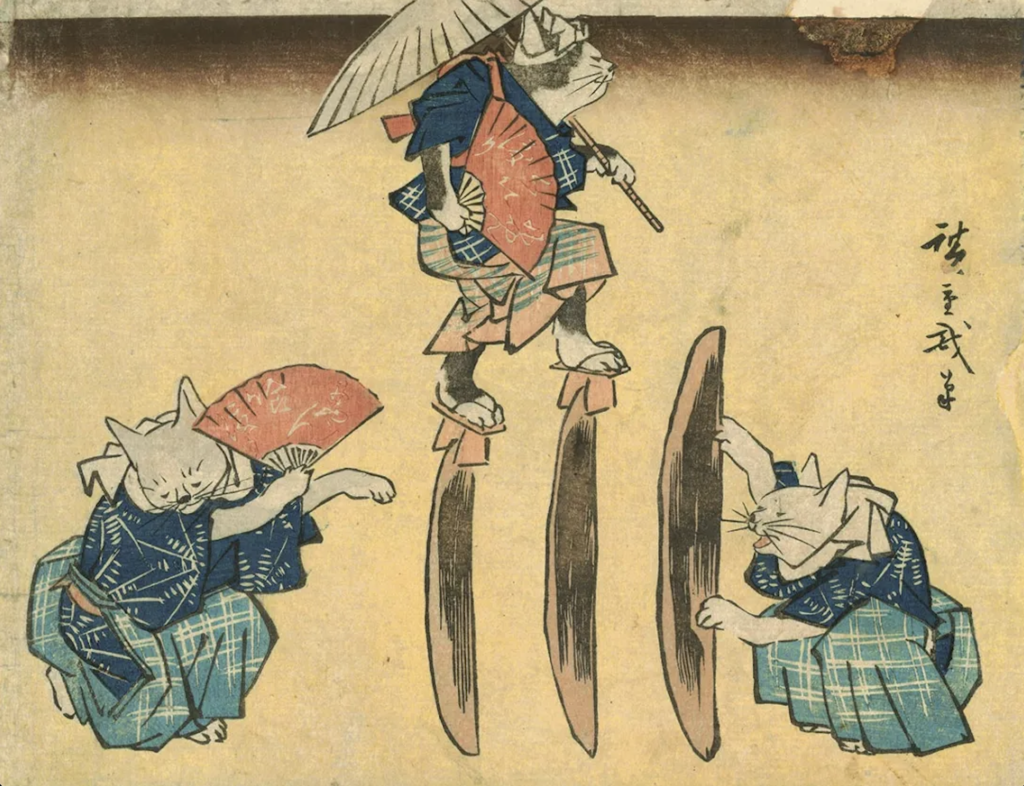
By A.A. Sanborn (Shimane-ken, 2009-11) for JQ magazine. A.A. is a graduate of Harvard University’s Regional Studies-East Asia (RSEA) program, and currently works as an executive associate at Asia Society in New York City.
It’s no surprise that, in an age where Cats of Istagram reign over our feed with a lofty air, Japan Society in New York’s new art exhibition Life of Cats: Selections from the Hiraki Ukiyo-e Collection is garnering serious buzz. Presenting 86 drawings, paintings, woodblock prints and decorative objects dating from the 17th to the early 20th century, this latest showcase taps into cat fancying for the digital age.
Without a doubt, Life of Cats is a work of heart: it’s made by people who love cats, for cat lovers. Chief among the cat fanciers at Japan Society is Miwako Tezuka, Japan Society Gallery director and curator of the exhibition. To put this display together, she studied over 6,000 prints from Hiraki Ukiyo-e Collection, as well as private American collections. Publications like Forbes, The Guardian and The New York Times have already sung this exhibition’s praises, and why not? Love ’em or hate ’em, you can’t deny that cats are in a category all their own—straddling the intersection of elegant, comical and vicious. And you get to see all their many guises in this dynamic display, which is already drawing substantial crowds.
Believe it or not, this type of exhibition already has precedence back in Japan. Cats have never been hotter, no matter what side of the Pacific you reside. In 2006, the Hiraki Foundation led the way for this new type of cat-themed exhibition in Tokyo, which has now become a national trend in its own right. As quoted from The Guardian, Tezuka said, “People are really crazy about cats in Japan….We thought a New York version of this exhibition would be a great way to introduce Japanese art to a wider audience.” Indeed, looking at the repertoire of recent Japan Society exhibits, they certainly have been hard at work drawing new types of crowds—not simply geared toward the art historian or otaku, exhibitions run the gamut from Japanese Art Deco to interactive digital art, reeling in hipsters and techies alike.
Justin’s Japan: Nippon in New York — Ghibli Premiere, L’arc~en~Ciel, Steve Aoki, Rinko Kikuchi
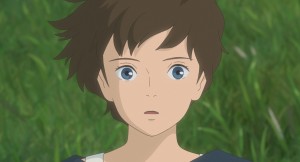
When Marnie Was There, the newest film from Studio Ghibli, premieres in North America Feb. 27 at DGA Theatre. (© 2014 GNDHDDTK)
By JQ magazine editor Justin Tedaldi (CIR Kobe-shi, 2001-02) for Examiner.com. Visit his Japanese culture page here for related stories.
Stay warm this winter with some hot local events, from an unmissable North American anime premiere, a documentary on one of Japan’s hottest acts, and concerts featuring some of the biggest names in electronic music, taiko, and indie rock.
This month’s highlights include:
Friday, Feb. 27, 8:30 p.m.
DGA Theatre, 110 West 57th Street
$16
North American premiere! The newest feature from Japan’s famed Studio Ghibli is a sweeping story of friendship, mystery, and discovery that delivers stirring emotions and breathtaking animation as only Ghibli can. When shy, artistic Anna moves to the seaside to live with her aunt and uncle, she stumbles upon an old mansion surrounded by marshes, and the mysterious young girl, Marnie, who lives there. The two girls instantly form a unique connection and friendship that blurs the lines between fantasy and reality. As the days go by, a nearly magnetic pull draws Anna back to the Marsh House again and again, and she begins to piece together the truth surrounding her strange new friend. Based on the novel by Joan G. Robinson, and directed by Hiromasa Yonebayashi (The Secret World of Arriety), When Marnie Was There has been described as “Ghibli Gothic,” with its moonlit seascapes, glowing orchestral score, and powerful dramatic portrayals that build to a stormy climax. In Japanese with English subtitles.
Sunday, March 1, 3:00 p.m.
Over the L’arc~en~Ciel: Documentary Films “World Tour 2012~”
Anthology Film Archives, 32 Second Avenue
$10
This new documentary follows a legendary rock band who never fear to take challenges on the international stage, when they have already reigned over the domestic music scene. L’Arc~en~Ciel, after celebrating their 20th anniversary, embarked on a massive world tour that no other Japanese rock band had ever done before. From March 3rd to May 31st, 2012, L’Arc~en~Ciel’s 14-city world tour hit Hong Kong, Bangkok, Shanghai, Taipei, New York, London, Paris, Singapore, Jakarta, Seoul, Yokohama, Osaka, Tokyo, and Honolulu with a total attendance of 450,000 people. The band became the first solo Japanese act ever to perform at Madison Square Garden. In Japanese with English subtitles.
Monday, March 9, 7:30 p.m. and 9:30 p.m.
Dizzy’s Club Coca-Cola, 10 Columbus Circle
$25, $15 students
Renowned Japanese pianist Chihiro Yamanaka is one of her native country’s most popular. Luckily for us, she recently moved to New York City. She’s especially well-known for leading trios, and with Jazz at Lincoln Center favorite Yasushi Nakamura on bass and rising star Kush Abadey on drums, this group stands up to those high expectations. On top of virtuosic, light-speed chops, Yamanaka has an irresistible bounce to her playing and writing.
For the complete story, click here.
JQ Magazine: Book Review — ‘Dreaming Spies’
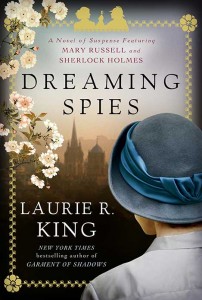
“King sets up an intriguing mystery, with myriad characters with distinctive personalities coming and going, and the conclusion has satisfying twists to keep the formula from being stale.” (Bantam House)
Are detective stories your thing? What about something involving an iconic figure of literature, ninjas, and Japan? Eden Law (Fukushima-ken, 2010-11) of JETAA New South Wales reviews the new mystery novel Dreaming Spies by Laurie R. King, the latest in her Mary Russell-Sherlock Holmes series, which is partially set in Japan and delves into Japanese culture quite a bit.
Picking up another person’s work is never easy, especially if you’re continuing a series of stories long after the original, canonical work ended, and in the time since then has become so popular and well-known that it forms part of modern pop culture. This practice is nothing new and is constantly ongoing—after all, witness the prevalence and popularity (or notoriety?) of fan fiction.
A few years back, a mash-up of high and low culture saw the creation of Pride and Prejudice and Zombies, which kicked off a whole slew of other entries such as Sense and Sensibility and Sea Monsters and Android Karenina…which shows that one way of resurrecting (pun fully intended) a story would be in the vein of a parody. However, rather than an attempt to create something interestingly imaginative (for example, repositioning the Bennet girls from helpless female chattel to arse-kicking women warriors), this genre is more cynically derivative and an attempt to cash into the zeitgeist of the lurching undead—Pride and Prejudice and Zombies, for example, will very soon be out in cinemas. Yay?
I haven’t read any of the other mash-up novels, so Dreaming Spies will be the first I’ve tackled of this growing (sub?)genre. Dreaming Spies isn’t a parody by any means, and its legendary figure of choice is one Sherlock Holmes, although the main master sleuth character here is Mary Russell, who in this story universe is the young wife of a decidedly older Holmes. Probably a wise choice, as tackling a character like Holmes would be like dating someone that just come out of a long-term relationship (i.e., someone that comes with a whole lot of baggage).
Justin’s Japan: NBA D-Leaguer Yuki Togashi
By JQ magazine editor Justin Tedaldi (CIR Kobe-shi, 2001-02) for Shukan NY Seikatsu. Visit his Examiner.com Japanese culture page here for related stories.
Originally hailing from Niigata Prefecture, 21-year-old Japanese national basketball team veteran Yuki Togashi joined the Texas Legends of the NBA Development League as a point guard last November after playing in four games with the Dallas Mavericks last year during Summer League.
Togashi made his D-League debut in New York on Jan. 24, shooting a field goal in the third quarter that helped the Legends rise to a 93-92 victory over the Westchester Knicks in their inaugural season.
That same week in January, the New York Times featured a story on Yuta Watanabe, 20, a towering 6-foot-8 point guard for George Washington University. A native of Kagawa Prefecture in Shikoku, the Times dubbed him a “Basketball Ambassador” in the headline, drawing comparisons with the Asian American NBA star (and former New York Knick) Jeremy Lin.
While the 5-foot-7 Togashi could be viewed as a long shot for the NBA (where the average player is at least a foot taller), he follows in the footsteps of players like Yuta Tabuse, the “Michael Jordan of Japan” who was the first Japanese-born basketball player to play in the NBA, appearing in four games with the Phoenix Suns during the 2004-05 NBA season.
As the influence of American basketball continues to captivate Asia, Japanese youth with dreams of turning pro are working hard to take part in this exciting new era.
Justin’s Japan: Nippon in New York — Kawaii Central, Japan Week, Mr. Big, the Last ‘Naruto’
By JQ magazine editor Justin Tedaldi (CIR Kobe-shi, 2001-02) for Examiner.com. Visit his Japanese culture page here for related stories.
Stay warm this winter with some hot local events, from an exhibition for the whole family that’s perfect for introducing kids to Tokyo life, a big-screen anime farewell to a certain ninja you won’t want to miss, and an annual showcase that brings the sights (and tastes) of Japan to vivid life.
This month’s highlights include:
Now through May 17
Children’s Museum of Manhattan, 212 West 83rd Street
$11 children/adults, $7 seniors
Experience Tokyo’s vibrant culture in a new interactive exhibit! Children will have fun learning about life in present day Japan in this playful, highly immersive environment that transports families to two distinct areas of Tokyo that exist side by side: one serene and exquisite, the other, too cute for words. Kawaii Central is a streetscape inspired by Tokyo’s bustling Harajuku district, bursting with color, trendy shops and cuter than cute styles. Kids sing karaoke, smile for the photo booth camera, serve up a seasonal Japanese meal, and design adorable mascots for their families. Plus, learn more about contemporary Japan through special programs for the public, free with admission.
Jan. 29-31, 7:30 p.m.
Miwa Yanagi Zero Hour: Tokyo Rose’s Last Tape
Japan Society, 333 East 47th Street
$35, $28 Japan Society members
Stranded in Japan during World War II, a young Japanese-American woman was forced to serve as a radio broadcaster for a propaganda program controlled by the Japanese Imperial Army, and was subsequently tried for treason. Seventy years later, this historic incident is brought to life through a visually stunning whodunit, conceived, written and directed by internationally renowned visual artist Miwa Yanagi. Brimming with iconic imagery from her rich body of photographic work, Zero Hour tells the multi-layered story of a woman caught between two nations during the war. This presentation marks Yanagi’s North American debut as a theater artist. Performed in English and Japanese with English subtitles.
Feb. 7-8
Music from Japan: East Asian Vibrancy and Highlights of MFJ Commissions III
Asia Society, 725 Park Avenue
$20-$40
Over two days, Music from Japan’s 40th anniversary will be commemorated with exciting cross-cultural collaborations between musicians from Japan and its neighboring countries, China and Korea. Three internationally acclaimed traditional instrumentalists from Japan, Korea, and China will perform contemporary and classical repertoire on their respective instruments. A series of solo works will be followed by a group improvisation and the world premiere of Unkai (Sea of Clouds), written by MFJ-commissioned composer Ned Rothenberg especially for the occasion. The following afternoon, to celebrate MFJ’s long history of commissioning Japanese and American composers to create new work, two new MFJ commissions will be presented alongside a retrospective of compositions from prior years.
For the complete story, click here.

